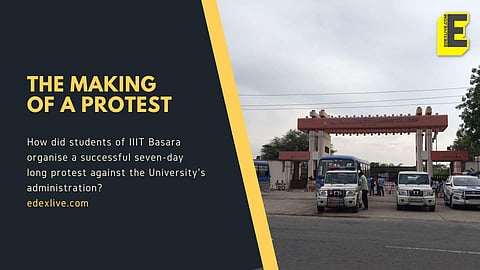

Heavy rains, scorching heat, silence from the administration and attempts at politicising the issue – nothing stopped the students of the Rajiv Gandhi University of Knowledge Technologies (RGUKT), popularly known as IIIT Basara, from protesting against the university’s administration over lack of permanent faculty and poor infrastructure in the campus.
The students finally called off their protest on Tuesday, June 21, after the state Education Minister Sabitha Indra Reddy agreed to their demands. One would be wondering how an all-students protest convinced the government to pay heed to their concerns in just seven days. The answer lies within the students itself.
Formation of SGC
It all started six months ago. The final year students of the Engineering batch of the university formed the Student Governing Council (SGC) on January 7, 2022, because they could never raise their voice against the faculty, the administration or any problems that they faced, said Lavanya Gundeti, Vice President of the SGC. The intention since the beginning was never to “fight” with or against anyone. “We just raised our voice…and asked why we are not getting what we are supposed to get in the university,” said Lavanya. The students protested against the abysmal conditions of the hostel rooms including food quality and infrastructure facilities.
The decision to protest, which is an extreme step, was not taken out of the blue. It was born out of multiple failed promises and reassurances by officials. Student representatives said that they followed proper protocol before reaching here. “We have been through many phases with the local administration here and we understood that they can’t help us out because there is no decision maker here,” said Harshavardhan Gurram, from the SGC who was also involved in the protest.
The only excuse that was constantly cited was that “the file is pending at the VC’s office and he has additional responsibilities,” said Harshavardhan. The representatives had also met the District Collector Musharraf Ali Farooqi for discussions. He, in fact, promised to visit the campus and solve problems. But again, none of it happened. They even took an appointment with the Vice-Chancellor but he also held his hand up in the air. “The protest was so intense because of this six-month-long journey,” added Harshavardhan.
Gathering support
“It was all possible because of students’ unity,” said Lavanya. One night before the protest on June 13, Class Representatives (CR) from each class were mobilised to inform them about the situation," said Lavanya. “We told them that it is not some violent movement or fight with the government, we are just sitting and asking for our rights..for what we have to get,” she said.
To go and sit in front of the administration block, without slogans and without noise was the memo given to the students since the beginning. If there was no response, then they must go and sit at the main gate. Every day. The students were not provoked nor were they forced to protest, said Harsha. They held internal discussions with students of every batch regularly and made them aware of the problems they have been facing for years.
Not just within the campus, the students of the University received support from other student organisations as well. Leaders of student unions like the Telangana Joint Action Committee (TJAC), Students’ Federation of India (SFI), All India Students’ Federation (AISF) and others reached the university to extend their support to the students. In fact, Opposition members visited the campus too.
Despite the political support, the students of the University never affiliated themselves with any political organization or outfit. “We never tagged anyone online as well and even when Ministers accused us of politicising the movement, we clarified it with them,” said Harsha. The only reason politicians supported us was because of our genuine demands, he added.
Role of social media
While at one hand students of the university were trying to communicate with the government, protests against the centre’s new Agnipath scheme had also erupted simultaneously across the country. This however, did not deter the students from their fight. They put their creative skills to the test with paintings, songs and other forms of art to draw attention to their protest.
Social media was filled with hashtags such as #IIITBasar, #VisitRGUKT and #ConsiderRGUKT. In fact, the SGC had a separate team that handled the social media aspects of the protests. Constantly updating when the protest started and ended, who came out in support and how many participated was the agenda of this team that was working day and night.
It was a step-by-step process that eventually worked out to be successful, said Lavanya. With the students’ support, the state government’s delegation agreed to all the demands put forth by SGC. Reports said that the Education Minister said that she would return to campus to ensure that promises are fulfilled by the concerned officials. “Because of students' unity…we made the government come to us,” said Lavanya.
